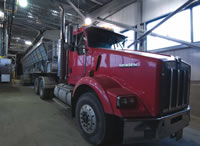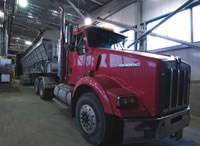
Much of the nickel and other metals mined in the Sudbury Basin is exported to the four corners of the world, but more and more of it is finding its way back in the form of cellphone, laptop and hybrid car batteries.
In 2000, Xstrata Nickel’s custom feed group in Sudbury processed 30,000 tonnes of material. This year, it’s forecasting 160,000 tonnes. A world leader in base metal recycling, the Xstrata Custom Feed group took a giant step forward earlier this year with the commissioning of a state-of-the-art calciner, a $29 million plant designed to boost throughput.
“We’ve been in the recycling business since the early ’80s,” said Bob Sutherland, Xstrata Nickel Custom Feed Manager. “It was a little niche market for us, but as time went on, we followed the nickel trail - looking at where our people were selling nickel - and the business kept growing and growing.”
Much of the material is in the form of mine concentrates, smelter by-products, high-grade slags and reverbs, but exotic feeds, including end of life batteries and aerospace scrap, are increasingly important. “Even part of the original space shuttle came up here,” said Sutherland.
“We built the calciner because we basically plateaued. We found we couldn’t get any more wet feed and feeds with organics into the smelter. Before we had the calciner, wet material gummed up the belts and hoppers, so it was a problem. It’s much easier conveying dry feeds.”
The calciner removes water and organics from scrap material by burning it at high temperatures in a rotary kiln 10 feet wide by 50 feet in length. The gases produced go to a secondary combusting chamber to burn off any contaminants.
All of the engineering and design was done in-house. A small pilot plant was built and tested in Wisconsin prior to final project approval, and construction was completed in December.
“What we don’t recover is encased in a slag on site, covered with a layer of soil and greened up,” said Sutherland.
Custom feed is sourced from the U.S., Europe, Japan, Taiwan and Africa by buyers who scour the world for acceptable material. An office in Pittsburgh covers the U.S. and Asia, and a buyer based in Brussels has responsibility for Europe, Russia and Africa.
“Health and safety and the environment are very important in the recycling business,” said Sutherland. “When we’re evaluating feeds, we will request a sample of the material and send it off to a lab for analysis.
“We’ll do a 50 element scan on it - basically the whole periodic table – looking for anything that will cause harm to our people, to the environment or to our process. If we have any concerns, we won’t touch the material.”
“The next thing we look at is how the material was produced. We require a material safety data sheet for it, and after we look at all that, we’ll do an economic evaluation to see if it’s a good fit for our process.”
When the material arrives at Xstrata Nickel’s custom feed facilities adjacent to the company’s Falconbridge smelter, the same detailed assays are repeated to make sure that the material delivered is the same as the original sample.
“We’re very safety conscious, and it has kept us out of trouble, ” said Sutherland. “When we have had people ship us off-spec material, or anything that’s a health and safety risk, we’ve returned the material.”
The custom feed group operates its recycling business under a government certificate of approval and a separate certificate of approval for the calciner.
New and exotic sources of nickel, cobalt and other metals include oil refinery catalysts used to absorb sulphur from fuel. There are even nickel-based edible oil catalysts used by margarine manufacturers to speed up the hydrogenating, or thickening, process. Catalysts used in the conversion of gas to liquid fuel – so-called GTL catalysts – will be another important source of material for recycling as GTL technology takes off.
“Lithium ion batteries are 25 per cent cobalt, so it’s better for us to recycle them and get the cobalt out of them than for them to end up in the dump,” said Sutherland.
Xstrata Nickel sources most of its batteries through the Rechargeable Battery Recycling Corporation (RBRC), a non-profit public service organization supported by more than 350 manufacturers.
Since 1994, the RBRC has collected and recycled more than 42 million pounds of rechargeable batteries with the help of approximately 50,000 retail and community partners across Canada and the U.S. Used batteries and cellphones are deposited by consumers in boxes at drop off points and sent to a collection facility, where they are sorted.
Xstrata Nickel’s Custom Feed operation is ideally positioned to take advantage of an unprecedented growth in recycling as hybrid vehicles gain market share, as tens of millions of consumers in developing countries such as China and India continue acquiring battery powered electronics such as cellphones and laptops and as Canada and other developed countries get more serious about diverting e-waste from landfill sites.
There are other recyclers in the world, but the Sudbury custom feed operation is unique because of its commitment to health and safety and the advanced technology it employs, said Sutherland.
“We’re a world leader in nickel recycling and, to qualify that further, we’re a world leader in recycling safely.
There are other smelters in places that will remain nameless that are more profit oriented and place less emphasis on health and safety.”
Xstrata Nickel’s Custom Feed group is focused on making a profit and ensuring that its processes are safe for both employees and the community.



